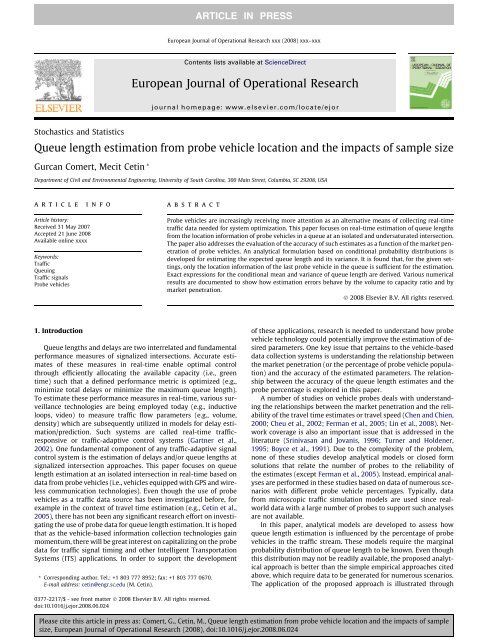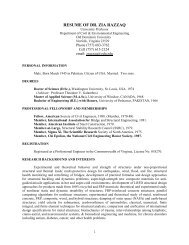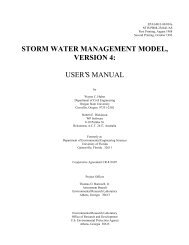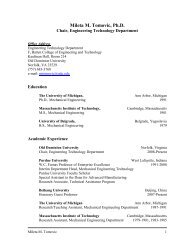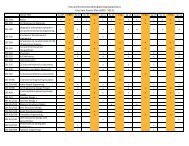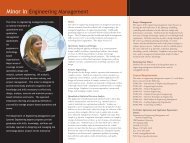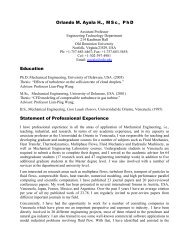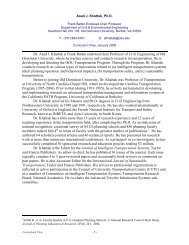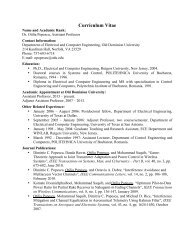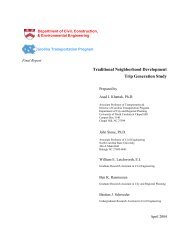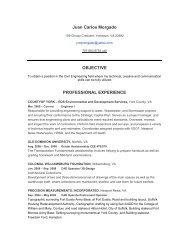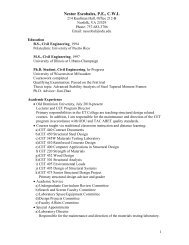Queue length estimation from probe vehicle ... - ResearchGate
Queue length estimation from probe vehicle ... - ResearchGate
Queue length estimation from probe vehicle ... - ResearchGate
Create successful ePaper yourself
Turn your PDF publications into a flip-book with our unique Google optimized e-Paper software.
ARTICLE IN PRESS2 G. Comert, M. Cetin / European Journal of Operational Research xxx (2008) xxx–xxxtwo examples for an isolated intersection with fixed signal timing.The arrivals are assumed to follow a discrete distribution such asPoisson whereas the <strong>vehicle</strong>s are assumed to queue vertically forsimplicity.It should be noted that there is a vast body of literature onqueues at signalized intersections. Since fixed cycle traffic light allowsa detailed analytical analysis, it has been studied by manyresearchers. One of the earliest studies is by Webster (1958) whogenerated relationships for the number of stops and delays by simulatingtraffic flow on a one-lane approach to an isolated signalizedintersection. In particular, the curve he fitted to the simulation resultshas been fundamental to traffic signal setting proceduressince its development. Miller (1963) found an approximation tothe average overflow queue for any arrival and departure distributions.Later, Newell (1965) derived an analytical approximation tothe mean queue <strong>length</strong> for general arrivals. McNeil (1968) deriveda formula for the expected delay and approximate mean of theoverflow queue <strong>length</strong> for general arrival process and constantdeparture rate.Other than the studies on the <strong>estimation</strong> of mean, there havebeen some attempts to obtain the probability function for thequeue <strong>length</strong>. Some researchers obtained the conditional probabilitydistribution of the overflow queue at the end of one periodgiven the queue <strong>length</strong> at the preceding period assuming homogenousPoisson arrival process (Haight, 1959; Heidemann, 1994;Mung et al., 1996). Yet some others derived the probability generatingfunction (pgf) of the stationary overflow queue (Darroch,1964) in the hope of obtaining the probability functions for delaysand queue <strong>length</strong>s. Obtaining a probability function <strong>from</strong> a pgf involvesinverting the pgf function (Abate and Whitt, 1992), and thisinversion process is quite complicated and entails finding complexroots and numerical evaluations of parameters (Van Leeuwaarden,2006). Therefore, the applicability of this procedure is very limitedand complicated. Following similar methods presented in Haight(1959); Olszewski (1990) used Markov chains to obtain the probabilitydistribution of overflow queue, and developed a computerprogram that estimates the mean queue <strong>length</strong> and its varianceunder different conditions such as stationary and non-stationaryarrival processes, and variable service rates. In a recent paper,Van Zuylen and Viti (2007) also used Markov chains to modelthe dynamics of the probability distributions of the total queueand overflow queue.Lastly, it is interesting to note that the general idea of using<strong>probe</strong>s to estimate the system state or system performance is notunique to vehicular traffic on roadways. In computer communicationnetworks, ‘‘<strong>probe</strong> packets” are sent <strong>from</strong> a source to one ormore receiver nodes in the network in order to deduce the qualityof service or performance (e.g., loss rate, delay) at the internalnodes or links (e.g., routers). In this technique, performance ofthe internal links/nodes is estimated by exploiting the correlationpresent in end-to-end (origin to destination) measurements obtained<strong>from</strong> <strong>probe</strong> packets (e.g., Xi et al., 2006; Duffield, 2006).This article is organized as follows: Section 2 introduces theproblem statement and the notation. Section 3 describes the analyticalformulation for the queue <strong>length</strong> <strong>estimation</strong> problem. Theapplication of the formulation is presented first for a fixed-cycletraffic light without considering the overflow queue in Section 4.Section 5 addresses the application of the formulation when overflowqueue is also considered. Lastly, Section 6 summarizes thefindings and results.<strong>vehicle</strong>s. The main objective is to estimate the total queue <strong>length</strong>,N, if the locations of <strong>probe</strong> <strong>vehicle</strong>s in the queue are known. Technically,the goal is to determine the conditional expected value of Ngiven the <strong>probe</strong> information, and to evaluate the error when thisconditional expected value is used as the predictor of the actualN, where N is the total number of <strong>vehicle</strong>s accumulated in thequeue at the end of red interval.It is assumed that the distance of <strong>probe</strong> <strong>vehicle</strong>s <strong>from</strong> the stopbar can be measured by location tracking technologies. For example,today’s differential GPS systems can provide one to three meteraccuracy (USDOT, 2008). For the purpose of locating <strong>vehicle</strong>s ona link, this accuracy would be sufficient. Once the position of a<strong>vehicle</strong> waiting on the link is known (i.e., distance <strong>from</strong> the stopbar), the number of <strong>vehicle</strong>s ahead of the subject <strong>vehicle</strong> can beestimated by assuming an average <strong>length</strong>/spacing per <strong>vehicle</strong>. Eventhough all <strong>vehicle</strong>s are assumed to be identical in this paper, it ispossible to capture the impact of multiple <strong>vehicle</strong> classes by selectingthe average <strong>vehicle</strong> <strong>length</strong> to be representative of different<strong>vehicle</strong> types. (The concept of using an average or effective <strong>vehicle</strong><strong>length</strong> is common in estimating density and speeds based on occupancy(i.e., percentage of time the detector is occupied/activated)measured by inductive loop detectors (e.g., Hellinga, 2002)). Anotherpossibility to model multiple <strong>vehicle</strong> classes is through specifyingarrival rates for each <strong>vehicle</strong> type. Even though incorporatingmultiple <strong>vehicle</strong> classes (e.g., busses, trucks) into the formulationpresented below is possible, this is avoided to simplify notationand presentation of the main ideas. Furthermore, this paper doesnot discuss information flow architecture and the exact nature ofdata processing needed to obtain the location of <strong>probe</strong>s in thequeue. Albeit important, such details as determining whether a<strong>probe</strong> <strong>vehicle</strong> is in the queue or not (i.e., waiting or moving), whichcan be determined based on its speed, acceleration and selectedthresholds, are not dealt with in this paper.For simplicity, the location of <strong>vehicle</strong>s in queue will be measuredin terms of the number of <strong>vehicle</strong>s. For example, in Fig. 1,there are three <strong>probe</strong> <strong>vehicle</strong>s and the location of the last <strong>probe</strong>,L p , is 6. The value of N is estimated in real-time at the end of eachcycle based on the location of <strong>probe</strong> <strong>vehicle</strong>s. Even though themodels are developed for vertical queues, this figure is includedto clarify the notation. In vertical queuing models, it is assumedthat <strong>vehicle</strong>s do not occupy space and can accelerate and decelerateinstantaneously.The models developed in this paper are based on the assumptionthat only <strong>probe</strong> <strong>vehicle</strong> locations are observable. From a technologicalpoint of view, a system that can collect and use othertypes of data (e.g., arrival times of <strong>probe</strong>s or joining back-of-queueevents) might also be envisioned. However, the scope of this paperis limited to those situations where only location data are used. Asit is demonstrated in the next section, the location of the last <strong>probe</strong>in the queue L p is sufficient for estimating the queue <strong>length</strong>;neither locations of other <strong>probe</strong> <strong>vehicle</strong>s nor the total number of<strong>probe</strong>s <strong>vehicle</strong>s in the queue N p are needed. It is assumedthat the percentage of <strong>probe</strong> <strong>vehicle</strong>s in the traffic stream p isknown.N=72. Problem statement and notationFig. 1 shows a snapshot of traffic at a signalized intersection approachat the end of a red phase. Solid rectangles represent <strong>probe</strong>L p= 6Fig. 1. Snapshot of an intersection right before the red interval terminates.Please cite this article in press as: Comert, G., Cetin, M., <strong>Queue</strong> <strong>length</strong> <strong>estimation</strong> <strong>from</strong> <strong>probe</strong> <strong>vehicle</strong> location and the impacts of samplesize, European Journal of Operational Research (2008), doi:10.1016/j.ejor.2008.06.024
ARTICLE IN PRESSG. Comert, M. Cetin / European Journal of Operational Research xxx (2008) xxx–xxx 3In order to estimate N, the conditional probability distributionof N given the <strong>probe</strong> locations is needed. The next section presentsthe general formulation whereas the following sections providetwo examples and some analyses. Even though the formulationin the next section can be generalized, the two example applicationsgiven in this paper are for a signal with fixed timing. Theapplication to actuated signals is a topic of future research.3. Analytical formulationAssuming that the proportion of <strong>probe</strong> <strong>vehicle</strong>s p is known, therelationship between the total number of <strong>probe</strong> <strong>vehicle</strong>s N p and thetotal number of all <strong>vehicle</strong>s in the queue N can be written asfollows:N p ¼ XNi¼1y i where y i 2f0; 1g and Pðy i ¼ 1Þ ¼p: ð1ÞThe equation above asserts that every <strong>vehicle</strong> has equal probabilityof being a <strong>probe</strong> <strong>vehicle</strong>. It is assumed that the random variablesy 1 ,y 2 ,... are independent and independent of N. Both N and N pare two discrete random variables. The formulation here is for ageneral probability mass function (pmf) for N, which is denotedby P(N = n). Given N = n, it follows that the number of <strong>probe</strong> <strong>vehicle</strong>sin the queue has the following binomial distribution.PðN p ¼ n p jN ¼ nÞ ¼n p np ð1 pÞ n np ; 0 6 p 6 1;n pn p ¼ 0; 1; 2; ...; n:Given N = n and N p = n p , the probability distribution for the locationof last <strong>probe</strong> (L p ) can be derived by considering the number of possiblecombinations. It can be verified that the conditional probabilityof L p given n and n p is l p 1n p 1PðL p ¼ l p jN ¼ n; N p ¼ n p Þ¼ ;nn pfor l p ¼ n p ; n p þ 1; ...; n; n p P 1: ð3ÞThis equation can be explained through an example case illustratedin Fig. 1. From Fig. 1, N =7,N p = 3, and L p = 6. The sample space forthe ‘‘experiment” is the possible combinations of choosing n p <strong>probe</strong>7<strong>vehicle</strong>s <strong>from</strong> n <strong>vehicle</strong>s, which is equal to . The number of elementsin the event space is equal to the number of possible place-3ments of the remaining <strong>probe</strong> <strong>vehicle</strong>s, other than the one atposition l p , into the previous slots since l p is fixed. In this example,5 slots are available to place 2 <strong>probe</strong>s. Thus, the event probability isthe number of elements in the event space divided by the numberof elementsin the sample space, which is PðL p ¼ 6jn ¼ 7;n p ¼ 3Þ ¼ 5 7.2 3As mentioned before, the main purpose is to find the conditionaldistribution of the queue <strong>length</strong> given the location of last<strong>probe</strong> and the total number of <strong>probe</strong>s, i.e., P(N = njL p = l p , N p = n p ).This conditional distribution can be written by using the Bayes’rule as follows:PðN ¼ njL p ¼ l p ; N p ¼ n p Þ¼ PðL p ¼ l p jN p ¼ n p ; N ¼ nÞPðN p ¼ n p jN ¼ nÞPðN ¼ nÞ: ð4ÞPðL p ¼ l p ; N p ¼ n p ÞBy the Total Probability LawPðL p ¼ l p ; N p ¼ n p Þ¼ X1k¼l pPðL p ¼ l p jN ¼ k; N p ¼ n p ÞPðN p¼ n p jN ¼ kÞPðN ¼ kÞ:ð2Þð5ÞThen (4) becomesPðN ¼ njL p ¼ l p ; N p ¼ n p Þ¼PðL p ¼ l p jN p ¼ n p ; N ¼ nÞPðN p ¼ n p jN ¼ nÞPðN ¼ nÞP 1k¼l pPðL p ¼ l p jN p ¼ n p ; N ¼ kÞPðN p ¼ n p jN ¼ kÞPðN ¼ kÞ : ð6ÞSubstituting the respective equations and after some simplifications,the following conditional distribution function for the queue<strong>length</strong> is obtainedPðN ¼ njL p ¼ l p ; N p ¼ n p Þ¼ ð1 pÞn PðN ¼ nÞP 1k¼l pð1 pÞ k PðN ¼ kÞ ;for l p P 1:As it turns out, this probability only depends on the location of last<strong>probe</strong> l p and does not depend on the total number of <strong>probe</strong>s in thequeue n p . It should be noted that Eq. (7) is valid for any probabilitydistribution of N. Even though the numerical examples presented inthe next sections are based on Poisson and Negative Binomial distributions,the formulation can be applied for any given P(N = n).Based on the above conditional probability distribution, the expectedqueue <strong>length</strong> can be easily computed as follows:EðNjL p ¼ l p Þ¼ X1¼ X1n¼l pnn¼l pnPðN ¼ njL p ¼ l p Þð7Þ½ð1 pÞŠ n PðN ¼ nÞP 1k¼l p½ð1 pÞŠ k PðN ¼ kÞ ; for l p P 1: ð8ÞThe equation above gives the mean of the random variable NjLp = lpwhich can be used as a predictor of the queue <strong>length</strong> given the<strong>probe</strong> location information. For real-time applications, this equationcan be used to estimate the queue <strong>length</strong>, provided that P(N = n) isknown.In order to assess how accuracy of this estimated queue <strong>length</strong>changes by the proportion of <strong>probe</strong> <strong>vehicle</strong>s p, some additional resultsare obtained. First, the conditional variance of the queue<strong>length</strong> (given l p ) can be written as follows:VARðNjL p ¼ l p Þ¼ X1n 2 ½ð1 pÞŠ n PðN ¼ nÞP 1n¼l p k¼l p½ð1 pÞŠ k PðN ¼ kÞ½EðNjL p ¼ l p ÞŠ 2 ; for l p P 1: ð9ÞSince the above variance depends on l p , a more general measurethat does not depend on l p is needed to determine the effects of pon accuracy. The error in the estimates, denoted by D, can be treatedas a random variable that is the difference between the actualqueue <strong>length</strong> N and its estimate:D ¼ N EðNjL p ¼ l p Þ: ð10ÞIf the expectation of both sides of this equation is taken, it can beseen that the expected error is zero. (Since E[E(NjL p = l p )] = E(N).)On the other hand, the variance of error is as follows:VarðDÞ ¼Var½N EðNjL p ¼ l p ÞŠ ¼ E½VarðNjL p ¼ l p ÞŠ: ð11ÞThe expected value on the right hand of this equation can be calculatedas follows:EðVarðNjL p ¼ l p ÞÞ ¼ X1l p¼0PðL p ¼ l p ÞVARðNjL p ¼ l p Þ:ð12ÞThis expected value in essence represents the weighted varianceover all possible values of l p . To calculate this weighted variance,the marginal probability distribution of L p is needed. This marginaldistribution can be readily written in terms of the conditional distributionsobtained thus farPlease cite this article in press as: Comert, G., Cetin, M., <strong>Queue</strong> <strong>length</strong> <strong>estimation</strong> <strong>from</strong> <strong>probe</strong> <strong>vehicle</strong> location and the impacts of samplesize, European Journal of Operational Research (2008), doi:10.1016/j.ejor.2008.06.024
ARTICLE IN PRESS4 G. Comert, M. Cetin / European Journal of Operational Research xxx (2008) xxx–xxxPðL p ¼ l p Þ¼ XlpX 1PðL p ¼ l p jN ¼ n; N p ¼ n p ÞPðN p ¼ n p jNn p¼0 n¼l p¼ nÞPðN ¼ nÞ:Then, the marginal distribution of L p becomesPðL p ¼ l p Þ¼ Xlpn p¼1ð13ÞX 1 l p 1p np ð1 pÞ n np PðN ¼ nÞ; for l p P 1;n¼l pn p 1PðL p ¼ 0Þ ¼ X1ð1 pÞ n PðN ¼ nÞ; for l p ¼ 0:n¼0ð14ÞThe formulation presented so far can be utilized to assess the relationshipbetween the percentage of <strong>probe</strong>s p and the accuracy of theestimated queue <strong>length</strong>s. The main input required is a probabilityfunction for the total number of <strong>vehicle</strong>s in the queue, P(N = n).The next two sections provide two examples to illustrate the applicationof this formulation.4. Analysis of arrivals on red (without overflow queue)At signalized intersections, if the overflow queue is ignored andthe number of arrivals per unit time is assumed to be Poisson withparameter k then, N is also a Poisson with parameter kR, where R isthe duration of the red interval. It should be noted that at isolatedintersections the use of Poisson distribution is common fordescribing the arrival process (Rouphail et al., 2001). Without lossof generality it is assumed that R = 1, then the probability functionfor N can be written asPðN ¼ nÞ ¼ e k k n; k > 0; n ¼ 0; 1; 2 ... ð15Þn!For illustration purposes an example is constructed where k is set to10. From Eq. (8), the expected queue <strong>length</strong> for this example can beobtained as follows:the percentage of <strong>probe</strong>s, and q is the parameter of the geometricdistribution.As it can be observed <strong>from</strong> Fig. 2, at smaller p and l p values (lessthan 10 or so) the expected value is close to k, as the most informationon-hand is based on the arrival rate. On the other hand, whenp is large then the expected value tends to the location of the last<strong>probe</strong>. Obviously, at the extreme when p = 1.0, the location of thelast <strong>probe</strong> is the same as the queue <strong>length</strong>.Fig. 3 shows the variance of the conditional queue <strong>length</strong> versusthe location of last <strong>probe</strong> for different p values. The results are inagreement with the intuition that variance decreases with higherp values. Variance is larger when l p is small; and as l p becomes largervariance tends to zero even for small p values. This implies thatqueue <strong>length</strong> can be estimated with more accuracy when l p islarge.The previous two figures illustrate how expected queue <strong>length</strong>and its variance change by the location of last <strong>probe</strong> in the queuebut they do not provide any information about the likelihood ofoccurrence of each l p value. This information is needed to assessthe overall or weighted accuracy at a given p value. Fig. 4 showsthe probability mass function of L p for different p values calculated<strong>from</strong> Eq. (14). Asp value increases the bell-shaped distribution becomesmore symmetrical around k = 1 and the probability of l pbeing zero (or the probability of having no <strong>probe</strong> = exp( kp)) getscloser to zero.Using the probability mass functions in Fig. 4, one can calculatethe weighted variance (see Eq. (12)) at a given p value to determinethe overall expected deviations of the estimates <strong>from</strong> the truequeue <strong>length</strong>s. Weighted variances are calculated at various p levelsand plotted in Fig. 5. As anticipated, the variance reduces as pincreases and becomes zero as p approaches to 1. This figure certainlyprovides valuable information needed in trading off the levelEðNjL p ¼ l p Þ¼ X1n¼l pn½ð1 pÞkŠnn! P 1k¼l p½ð1pÞkŠ kk!; for l p P 1: ð16ÞFig. 2 shows the relationship between the expected queue <strong>length</strong>versus the location of the last <strong>probe</strong> l p for five different <strong>probe</strong> <strong>vehicle</strong>proportions p. It can be observed that, for all p values, the expectedqueue <strong>length</strong> converges to the location of last <strong>probe</strong> as l pincreases. Therefore, one can write lim lp!1ðEðNjL p ¼ l p Þ L p Þ¼0.This limit is numerically verified for Poisson distribution P(N = n).However, it should be noted that this result depends on the probabilitydistribution of N. For example, if P(N = n) is geometric, thenlim lp!1ðEðNjL p ¼ l p Þ L p Þ¼a=ð1 aÞ, where a =(1 p)(1 q), p isFig. 3. Variance of the conditional queue <strong>length</strong> versus L p .Fig. 2. Expected value of queue <strong>length</strong> given the location of the last <strong>probe</strong> <strong>vehicle</strong> inthe queue.Fig. 4. Marginal probability mass function (pmf) of L p .Please cite this article in press as: Comert, G., Cetin, M., <strong>Queue</strong> <strong>length</strong> <strong>estimation</strong> <strong>from</strong> <strong>probe</strong> <strong>vehicle</strong> location and the impacts of samplesize, European Journal of Operational Research (2008), doi:10.1016/j.ejor.2008.06.024
ARTICLE IN PRESSG. Comert, M. Cetin / European Journal of Operational Research xxx (2008) xxx–xxx 5Fig. 5. Variance of error versus p.of accuracy and the cost of data collection (i.e., percentage of <strong>probe</strong><strong>vehicle</strong>s).Even though Fig. 5 provides some guidance on trading off accuracyand p, confidence intervals and confidence limits are moreinformative for making such decisions. In order to construct confidenceintervals for the overall error at a given p value, one needs toknow the pmf of the error shown in Eq. (10). However, derivingthis pmf seems to be prohibitive due to the complexity ofthe expressions involved (e.g., the probability distribution ofE(NjL p = l p )). Instead, one- and two-sigma deviations (i.e., standarddeviations) for expected queue <strong>length</strong> are computed and shown inFig. 6. If one can assume that a normal approximation is valid then,a 95% confidence interval would nearly coincide with the two-sigmacurve in Fig. 6.The previous figures are constructed for a fixed arrival rate kwhich essentially determines the average queue <strong>length</strong>. In orderto see how the error behaves with different arrival rates, Fig. 7 isconstructed. It shows the error that is normalized by the arrivalrate k in percentage as a function of p at various k levels. At a givenFig. 6. Deviations <strong>from</strong> the expected total queue <strong>length</strong> versus p.Var(D)11010090807060504030201000 0.05 0.1 0.15 0.2 0.25 0.3 0.35 0.4 0.45 0.5Proportion of <strong>probe</strong>s,pp level, the relative or normalized error is smaller for larger k valueswhich implies that the relative error gets smaller as averagequeue <strong>length</strong> increases.4.1. Analysis with different arrival processesThe formulation presented in Section 3 is applicable to anyprobability distribution of N,P(N = n). To explore the behavior of errorswith different P(N = n), the results for Negative Binomial andPoisson arrivals are plotted in Fig. 8. For illustration purposes, NegativeBinomial is selected to represent P(N = n). It should be notedthat the overflow queue is not considered in these examples;therefore, probability distribution of N is the same thing as theprobability distribution of total arrivals is a given time period.The probability mass function for Negative Binomial isPðN ¼ nÞ ¼ n þ r 1nq r ð1PoissonGeometricNeg.Binomial(r=5)Neg.Binomial(r=10)Neg.Binomial(r=35)Fig. 8. Variance of errors for Poisson and Negative Binomial Distributions.qÞ n ; n ¼ 0; 1; ..., where n is consideredhere as the total number of arrivals or total number of <strong>vehicle</strong>sin queue. The expected value for average queue <strong>length</strong> isselected to be 10 <strong>vehicle</strong>s per 45 seconds of red duration in orderto be consistent with the example above. The mean for a NegativeBinomial random number can be found by r(1 q)/q. The errorsare calculated for different r values as shown in Fig. 8 where q isselected such that the mean is always equal to 10. The tail of thePoisson distribution is shorter than that of the Negative Binomialat low r values. Therefore, the number of events with larger arrivalswill be fewer if a Poisson distribution is used than if a NegativeBinomial distribution is used when both models have the same expectedvalue (Banks et al., 2001). Fig. 8 shows that the model givesconsistent results with this observation. It is known that as theparameter r increases the shape of the Negative Binomial resemblesto the Poisson, and consequently the Negative Binomial linesin Fig. 8 gets closer to that of the Poisson as r increases.E(N) ± σ and 2σ252015105Deviations <strong>from</strong> E(N)E(N)1− σ2− σ00 0.1 0.2 0.3 0.4 0.5 0.6 0.7 0.8 0.9 1Proportion of Probes, pFig. 7. Percent error for different average queue <strong>length</strong>s at various p levels.Fig. 9. Deviations <strong>from</strong> the expected total queue <strong>length</strong> versus p.Please cite this article in press as: Comert, G., Cetin, M., <strong>Queue</strong> <strong>length</strong> <strong>estimation</strong> <strong>from</strong> <strong>probe</strong> <strong>vehicle</strong> location and the impacts of samplesize, European Journal of Operational Research (2008), doi:10.1016/j.ejor.2008.06.024
ARTICLE IN PRESS6 G. Comert, M. Cetin / European Journal of Operational Research xxx (2008) xxx–xxxTable 1Two-sigma deviations at various p levelsp 0.0001 0.1 0.2 0.3 0.4 0.5 0.6 0.7 0.8 0.9 0.9999# of <strong>vehicle</strong> (2r) 8.5 6.6 5.1 4.1 3.3 2.6 2.1 1.5 1.1 0.7 0.0Dev. % (2r) 75 58 45 36 29 23 18 13 10 6 05. Analysis with the overflow queueIn the previous section, the overflow queue (cycle to cycle overflow)or the residual queue at the end of green period is ignored. Inthis section, the total queue <strong>length</strong> <strong>estimation</strong> that also includesthe overflow queue due to randomness is presented. It is still assumedthat average demand is less than the capacity – undersaturatedconditions. Let N o be the overflow queue <strong>length</strong> and N r be thequeue <strong>length</strong> that occurs <strong>from</strong> new arrivals during the red period.The total queue <strong>length</strong> to be estimated, N, is the summation of N oand N r . At any given cycle, <strong>probe</strong> <strong>vehicle</strong>s may or may not be presentin one or both of N o and N r , leading to four possible scenarios.Irrespective of where a <strong>probe</strong> <strong>vehicle</strong> is in the queue, the generalformulation and equations presented before are applicable as longas the marginal probability function, P(N = n), is known. Therefore,the analysis can be carried out without dealing with these scenariosindividually.The main input needed is the marginal probability of the totalqueue <strong>length</strong>, P(N = n). For a traffic light with fixed timing, someresearchers developed models that allow calculation of P(N = n)numerically. These models involve finding the complex roots ofthe pgf of overflow queue in equilibrium (Abate and Whitt,1992). The application of these models also requires numericalevaluation and approximations for pgf inversion (Van Leeuwaarden,2006). The second alternative to find P(N = n) is through simulation.In this paper, a simulation model is developed todetermine P(N = n).In this example, arrivals are assumed to be Poisson with a rateof k, and the <strong>vehicle</strong>s are assumed to depart <strong>from</strong> the stopbar at aconstant rate during the green, which is assumed to be 2 secondsper <strong>vehicle</strong>. Therefore, the service rate l is equal to the green durationdivided by 2. The total queue <strong>length</strong> is defined as N = N o + N r inequilibrium conditions. The distribution of total queue <strong>length</strong>,P(N = n), is determined by running the simulation multiple times.The traffic light parameters are chosen as follows: cycle <strong>length</strong>,C = 90 seconds; red period, r = 45 seconds; and green period,g = 45 seconds. The arrival rate, k, is set to 20 <strong>vehicle</strong>s per cycle.These selected parameters correspond to a v/c ratio of 0.89. Simulationis run for 180,000 seconds and replicated 1000 times. Thefirst 200-cycles in each replication is considered as the warm-upperiod and not included in calculating the equilibrium distributionof P(N = n).Once the P(N = n) is obtained, an analysis similar to the one presentedin the previous section can be performed to determine theTable 2Results for various q valuesp = 0.5q = k/l k Mean = E(N) r 2 = E(VAR(Njl p )) 2r Dev. (%)0.50 11.25 5.630 1.295 2.3 400.60 13.50 6.757 1.395 2.4 350.70 15.75 7.936 1.472 2.4 310.80 18.00 9.338 1.553 2.5 270.88 20.00 11.394 1.654 2.6 230.90 20.25 11.816 1.672 2.6 220.95 21.38 14.938 1.766 2.7 180.99 22.00 23.580 1.876 2.7 12100* σ/E(N)70605040302010λ/μ=0.6λ/μ=0.7λ/μ=0.8λ/μ=0.9λ/μ=0.9900 0.1 0.2 0.3 0.4 0.5 0.6 0.7 0.8 0.9 1Proportion of Probes, pFig. 10. Normalized errors versus proportion of <strong>probe</strong>s at different q values.expected total queue <strong>length</strong> and variance. For brevity, only the resultsthat show how error changes by the proportion of <strong>probe</strong> <strong>vehicle</strong>sare presented here. Fig. 9 shows the expected total queue<strong>length</strong> and one- and two-sigma deviations <strong>from</strong> the mean versusthe proportion of <strong>probe</strong>s, p. Compared to Fig. 6, the mean is shiftedupwards due to the effect of the overflow queue, and the deviationsshow similar behavior.The results presented in Fig. 9 are summarized in Table 1 to easilysee the improvement in errors when p gets larger. The 2 rdeviations are presented in two formats: as absolute values (row2) and as percentage of the mean (row 3). The values in row 3can also be interpreted as the coefficient of variance (cv) multipliedby two. It is useful to look at both absolute deviations in terms ofthe number of <strong>vehicle</strong>s and the percent deviations since the targeterror criterion can be expressed in both formats. For example, for80% <strong>probe</strong> <strong>vehicle</strong>s, the expected error is about 10% and the absoluteerror is about ±1 <strong>vehicle</strong>. If the error is assumed to follow anormal distribution then, these error rates roughly correspond toa 95% confidence interval.Thus far, the results presented are for a constant arrival ratewith a v/c ratio or q equal to 0.89. To understand the impact of qon accuracy, the arrival rate is varied to generate the scenariosshown in Table 2 where the percent of <strong>probe</strong> <strong>vehicle</strong>s p is kept constantat 50%. For each one of these scenarios, the simulation programis run separately to obtain P(N = n) and the equationsdescribed above are utilized to estimate the means and variances.The last two columns of Table 2 convey the same type of informationpresented in Table 1. As it can be observed, absolute deviations(2r) are not increasing significantly as v/c or q increases. On theother hand, percent deviations <strong>from</strong> the mean are decreasing substantiallywith increasing q.In order to depict a more comprehensive picture, Fig. 10 is createdto analyze the errors both as a function of <strong>probe</strong> proportions pand q = k/l values. The normalized percent error (or percent coefficientof variation) decreases with increasing proportion of <strong>probe</strong>sas expected. However, the errors at different q values show a complexbehavior as a function of p. For very small p values (less than5%) the relative error gets very large when q approaches 1. This canbe attributed to the increase in the size and variance of the initialqueue. For larger p values, the relative error is smaller for larger qvalues as also indicated in the results of Table 2.Please cite this article in press as: Comert, G., Cetin, M., <strong>Queue</strong> <strong>length</strong> <strong>estimation</strong> <strong>from</strong> <strong>probe</strong> <strong>vehicle</strong> location and the impacts of samplesize, European Journal of Operational Research (2008), doi:10.1016/j.ejor.2008.06.024
ARTICLE IN PRESSG. Comert, M. Cetin / European Journal of Operational Research xxx (2008) xxx–xxx 76. ConclusionsThis paper presents a statistical method for real-time <strong>estimation</strong>of queue <strong>length</strong> at a signalized intersection approach <strong>from</strong><strong>probe</strong> <strong>vehicle</strong> data under the assumption that the marginal probabilitydistribution of the queue <strong>length</strong> P(N = n) is known. Analyticalexpressions are derived for queue <strong>length</strong> <strong>estimation</strong> and for erroranalysis where the queue <strong>length</strong> is estimated based on the positionor location of <strong>probe</strong> <strong>vehicle</strong>s in the queue. It is found that, in termsof real-time data, only location of the last <strong>probe</strong> <strong>vehicle</strong> l p in thequeue is sufficient for the <strong>estimation</strong> (i.e., location of other <strong>probe</strong>sor the total number of <strong>probe</strong> <strong>vehicle</strong>s in the queue are redundant).Therefore, <strong>from</strong> the technological perspective, tracking only thelocation of the last <strong>probe</strong> in the queue is sufficient. Obviously, thisconclusion is valid for the conditions and assumptions consideredin the paper (e.g., steady-state conditions, known arrival rate). Forexample, any information on the arrival times of <strong>probe</strong> <strong>vehicle</strong>s isnot considered here, which can potentially provide additional benefitsto the queue <strong>length</strong> <strong>estimation</strong>.Exact expressions for the conditional mean and variance of thequeue <strong>length</strong> for a given l p are derived. Two example applicationsare presented for a traffic light with fixed timing where arrivals areassumed to follow a Poisson distribution. In the first example,overflow queue is not considered and therefore the probability distributionof the queue <strong>length</strong> becomes Poisson. In the secondexample, overflow queue is considered and P(N = n) is derived <strong>from</strong>simulated data since there is no readily available analytical modelto determine P(N = n). For both of these examples, the relationshipbetween the percentage of <strong>probe</strong> <strong>vehicle</strong>s p and the accuracy of theestimates is analyzed. Obviously, as p increases error diminishes.The results can be used to select an appropriate p for given confidencelevel and error level. In addition, it is found that as volumeto capacity or q increases, the absolute error in the queue <strong>length</strong>estimates does not increase significantly whereas the percentageerror relative to the mean decreases significantly for p values largerthan 10%. This implies that queue <strong>length</strong>s can be estimated moreeffectively at relatively high volumes. It should be noted that theseresults are obtained for undersaturated conditions (q < 1.0).This paper presents what appears to be the first attempt to formulatethe problem of estimating the queue <strong>length</strong> <strong>from</strong> <strong>probe</strong><strong>vehicle</strong> data. The presented formulation relies on a priori knowledgeof the marginal distribution of N. Therefore, specifying anaccurate distribution for N is an important issue. There are numerousopportunities for future research. Extensions that deal withtime dependent demand, multiple intersections, actuated signals,and oversaturated conditions are some obvious ones. In addition,the use of other types of <strong>probe</strong> <strong>vehicle</strong> data, beyond the <strong>probe</strong> <strong>vehicle</strong>location, should also be investigated.AcknowledgementsThe authors wish to thank the University of South Carolina forsupporting this research. The authors are also grateful to the anonymousreviewers who provided very detailed and insightful commentsthat helped us improve the quality of this manuscript.ReferencesAbate, J., Whitt, W., 1992. Numerical inversion of probability generating functions.Operations Research Letters 12, 245–251.Banks, J., Carson II, J.S., Nelson, B.L., Nicol, D.M., 2001. Discrete-Event SystemSimulation. Prentice-Hall, New Jersey.Boyce, D.E., Hicks, J., Sen, A., 1991. In-<strong>vehicle</strong> navigation requirements formonitoring link travel times in a dynamic route guidance system. OperationsReview 8 (1), 17–24.Cetin, M., List, G.F., Zhou, Y., 2005. Factors affecting the minimum number of <strong>probe</strong>srequired for reliable travel time <strong>estimation</strong>. Transportation Research Record1917, 37–44.Chen, M., Chien, S.I.J., 2000. Determining the number of <strong>probe</strong> <strong>vehicle</strong>s for freewaytravel time <strong>estimation</strong> by microscopic simulation. Transportation ResearchRecord 1719, 61–68.Cheu, R.L., Xie, C., Lee, D., 2002. Probe <strong>vehicle</strong> population and sample size for arterialspeed <strong>estimation</strong>. Computer-Aided Civil and Infrastructure Engineering 17 (1),53–60.Darroch, J.N., 1964. On the traffic-light queue. The Annals of MathematicalStatistics, 380–388.Duffield, N.G., 2006. Network tomography of binary network performancecharacteristics. IEEE Transactions on Information Theory 52, 5373–5388.Ferman, M.A., Blumenfeld, D.E., Dai, X., 2005. An analytical evaluation of a real-timetraffic information system using <strong>probe</strong> <strong>vehicle</strong>s. Journal of IntelligentTransportation Systems: Technology, Planning, and Operations 9 (1), 23–34.Gartner, N.H., Pooran, F.J., Andrews, C.M., 2002. Optimized policies for adaptivecontrol systems: Implementation and field testing. Transportation ResearchRecord 1811, 148–156.Haight, F.A., 1959. Overflow at a traffic flow. Biometrika 46 (3-4), 420–424.Heidemann, D., 1994. <strong>Queue</strong> <strong>length</strong> and delay distributions at signalizedintersections. Transportation Research Part B 28 (5), 624–635.Hellinga, B.R., 2002. Improving freeway speed estimates <strong>from</strong> single-loop detectors.Journal of Transportation Engineering 128 (1), 58–67.Lin, I., Rong, H., Kornhauser, A.L., 2008. Estimating nationwide link speeddistribution using <strong>probe</strong> position data. Journal of Intelligent TransportationSystems 12 (1), 29–37.McNeil, D.R., 1968. A solution to the fixed cycle traffic light problem for compoundPoisson arrivals. Journal of Applied Probability 5, 624–635.Miller, A.J., 1963. Settings for fixed-cycle traffic signals. Operations ResearchQuarterly 14, 373–386.Mung, K.S.G., Poon, A.C.K., Lam, W.H.K., 1996. Distributions of queue <strong>length</strong>s at fixedtime traffic signals. Transportation Research Part B 30 (6), 421–439.Newell, G.F., 1965. Approximation methods for queues with application to thefixed-cycle traffic light. SIAM Review 7, 223–240.Olszewski, P., 1990. Modeling of queue probability distribution at traffic signals. In:Koshi, M. (Ed.), Transportation and Traffic Theory. Elsevier, Amsterdam, pp.569–588.Rouphail, N., Tarko, A., Li, J., 2001. Traffic flows at signalized intersections. TrafficFlow Theory Monograph.Srinivasan, K.K., Jovanis, P.P., 1996. Determination of number of <strong>probe</strong> <strong>vehicle</strong>srequired for reliable travel time measurement in urban network. TransportationResearch Record 1537, 5–22.Turner, S., Holdener, D., 1995. Probe <strong>vehicle</strong> sample sizes for real-time information:The Houston experience. In: Proceedings of the Vehicle Navigation &Information Systems Conference, Seattle, WA, United States, pp. 3–10.USDOT, 2008. Nationwide Differential Global Positioning System Program FactSheet, Turner-Fairbank Highway Research Center. , visited on February 26.Van Leeuwaarden, V.J.S.H., 2006. Delay analysis for the fixed-cycle traffic-lightqueue. Transportation Science 40 (2), 189–199.Van Zuylen, H.J., Viti, F., 2007. A probabilistic model for queues, delays and waitingtime at controlled intersections. In: 86th Annual Meeting of the TransportationResearch Board CD-ROM.Webster, F.V., 1958. Traffic signal settings. Road Research Laboratory TechnicalPaper No. 39, HMSO, London.Xi, B., Michalidis, G., Nair, V.N., 2006. Estimating network loss rates using activetomography. Journal of the American Statistical Association 101 (476), 1430–1448.Please cite this article in press as: Comert, G., Cetin, M., <strong>Queue</strong> <strong>length</strong> <strong>estimation</strong> <strong>from</strong> <strong>probe</strong> <strong>vehicle</strong> location and the impacts of samplesize, European Journal of Operational Research (2008), doi:10.1016/j.ejor.2008.06.024


